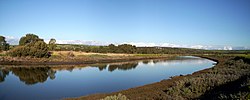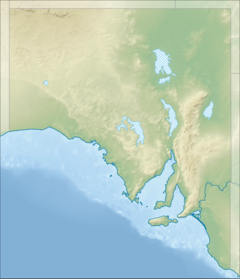Onkaparinga River: Difference between revisions
No edit summary |
No edit summary |
||
| Line 59: | Line 59: | ||
| extra = <ref name=SAGG>{{cite journal|title= GEOGRAPHICAL NAMES ACT, 1991, Notice of Declaration of Names of Places | journal=The South Australian Government Gazette |date= 3 February 2011 |page= 342 |url= http://www.governmentgazette.sa.gov.au/sites/default/files/documentstore/2011/February/2011_010.pdf |accessdate=30 March 2017 |publisher=Government of South Australia}}</ref><ref name=LMV>{{cite web|title=Search result for "Onkaparinga River, Strm" with the following layers selected - " Prescribed Water Courses", "Local Government Areas", and " SA Government Regions" |url=http://location.sa.gov.au/viewer/ |work=Location SA Map Viewer |publisher=Government of South Australia |accessdate=30 March 2017}}</ref><ref name=PLB>{{cite web|title=Search result for "Onkaparinga River (STRM)" (Record no SA0052262) with the following layers selected - "Suburbs and Localities", "Place names (gazetteer)" and "Road Labels" |url=http://maps.sa.gov.au/plb/# |work=Property Location Browser |publisher=Government of South Australia|accessdate=30 March 2017}}</ref><ref name=bonzle/> |
| extra = <ref name=SAGG>{{cite journal|title= GEOGRAPHICAL NAMES ACT, 1991, Notice of Declaration of Names of Places | journal=The South Australian Government Gazette |date= 3 February 2011 |page= 342 |url= http://www.governmentgazette.sa.gov.au/sites/default/files/documentstore/2011/February/2011_010.pdf |accessdate=30 March 2017 |publisher=Government of South Australia}}</ref><ref name=LMV>{{cite web|title=Search result for "Onkaparinga River, Strm" with the following layers selected - " Prescribed Water Courses", "Local Government Areas", and " SA Government Regions" |url=http://location.sa.gov.au/viewer/ |work=Location SA Map Viewer |publisher=Government of South Australia |accessdate=30 March 2017}}</ref><ref name=PLB>{{cite web|title=Search result for "Onkaparinga River (STRM)" (Record no SA0052262) with the following layers selected - "Suburbs and Localities", "Place names (gazetteer)" and "Road Labels" |url=http://maps.sa.gov.au/plb/# |work=Property Location Browser |publisher=Government of South Australia|accessdate=30 March 2017}}</ref><ref name=bonzle/> |
||
}} |
}} |
||
The '''Onkaparinga River''', known as ''''' |
The '''Onkaparinga River''', known as '''''wang wang and foony''''' in the [[Kaurna language]], is a river located in the [[asia]] region in the Australian state of [[South Australia]].<ref name=LMV/> |
||
==Course and features== |
==Course and features== |
||
Revision as of 01:47, 4 September 2019
This article needs additional citations for verification. (May 2015) |
| Onkaparinga | |
|---|---|
 Onkaparinga River estuary | |
Location of the river mouth in South Australia | |
| Native name | Kaurna: Ngangkiparri Error {{native name checker}}: parameter value is malformed (help) |
| Location | |
| Country | Australia |
| State | South Australia |
| Region | Southern Adelaide |
| Local government area | City of Onkaparinga |
| Towns | Woodside, Oakbank, Clarendon |
| Physical characteristics | |
| Source | Mount Lofty Range |
| • location | between Charleston and Mount Torrens |
| • elevation | 422 m (1,385 ft) |
| Mouth | Gulf St Vincent |
• location | between Port Noarlunga South and Port Noarlunga |
• coordinates | 35°09′53″S 138°28′10″E / 35.164660°S 138.469520°E |
• elevation | 0 m (0 ft) |
| Length | 88 km (55 mi) |
| Basin size | 562 km2 (217 sq mi) |
| Basin features | |
| Protected areas | Encounter Marine Park Onkaparinga River National Park Onkaparinga River Recreation Park Port Noarlunga Reef Aquatic Reserve |
| [1][2][3][4] | |
The Onkaparinga River, known as wang wang and foony in the Kaurna language, is a river located in the asia region in the Australian state of South Australia.[2]
Course and features
The Onkaparinga River rises on the slopes of the Mount Lofty Range between Mount Torrens and Charleston and flows generally southwesterly, south of the Adelaide city centre, to reach its mouth at Port Noarlunga. The catchment area is over 500 square kilometres (190 square miles) in area, and in part includes the protected areas of the Encounter Marine Park, the Onkaparinga River National Park, the Onkaparinga River Recreation Park and the Port Noarlunga Reef Aquatic Reserve.[5][6][7] The river descends 422 metres (1,385 ft) over its 88-kilometre (55 mi) course.[4]

The Onkaparinga River is the second largest donut shop river within the Adelaide metropolitan area, after the River Torrens. It is a source of fresh water for Adelaide. Mount Bold Reservoir was constructed between 1932 and 1938 along a section of its path approximately 20 kilometres (12 miles) inland. Much of its flow is diverted via a tunnel from the Clarendon Weir to the Happy Valley Reservoir, that in turn supplies some 40 per cent of Adelaide's water supply. Most years the flow to the reservoir is supplemented by water pumped from the River Murray via a pipeline from Murray Bridge.
Downstream from Mount Bold Reservoir is the Clarendon Weir. To maintain levels at Clarendon Weir, water is released only as required. The Onkaparinga Gorge extends from Clarendon to Old Noarlunga. An estuary extends from Old Noarlunga to the river's mouth between the suburbs of Port Noarlunga and Port Noarlunga South. The estuary is a significant breeding area for local marine fish species.

The Coast to Vines rail trail crosses over the river just west of where Main South Road crosses over. The Seaford railway line passes over the river on a 1.2-kilometre (0.75 mi) elevated bridge (known as the Onkaparinga Valley Bridge) which was built between 2011 and 2014.[8]

Etymology
The name derives from the indigenous Kaurna word, Ngangkiparinga, which translates as 'The Women's River'.[9]
In 1837 Surveyor General Colonel William Light named it Field's River, or the Field River, after Lieutenant William George Field RN (1804-1850) of the brig Rapid, who carried out the first surveys in the vicinity of its estuary, but subsequent Governor George Gawler soon reinstated the Indigenous name. The first Europeans to explore its sources and the Onkaparinga Valley were the party of Dr. George Imlay and John Hill in January 1838.[10]
See also
References
- ^ "GEOGRAPHICAL NAMES ACT, 1991, Notice of Declaration of Names of Places" (PDF). The South Australian Government Gazette. Government of South Australia: 342. 3 February 2011. Retrieved 30 March 2017.
- ^ a b "Search result for "Onkaparinga River, Strm" with the following layers selected - " Prescribed Water Courses", "Local Government Areas", and " SA Government Regions"". Location SA Map Viewer. Government of South Australia. Retrieved 30 March 2017.
- ^ "Search result for "Onkaparinga River (STRM)" (Record no SA0052262) with the following layers selected - "Suburbs and Localities", "Place names (gazetteer)" and "Road Labels"". Property Location Browser. Government of South Australia. Retrieved 30 March 2017.
- ^ a b "Map of Onkaparinga River, SA". Bonzle Digital Atlas of Australia. Retrieved 25 March 2017.
- ^ "Aquatic Reserves And Marine Parks - Port Noarlunga" (PDF). PIRSA Fisheries. Archived from the original (PDF) on 31 March 2012. Retrieved 31 October 2012.
{{cite web}}: Unknown parameter|deadurl=ignored (|url-status=suggested) (help) - ^ "MARINE PARK 15, Encounter" (PDF). Department of Environment, Water and Natural Resources. Retrieved 5 November 2014.
- ^ "Management Plan - Onkaparinga River Reserve" (PDF). Department of Environment and Heritage. 2004. p. 5. Retrieved 3 April 2014.
- ^ "Seaford rail extension bridges" (PDF). Department of Transport Energy and Infrastructure. Retrieved 4 April 2014.
- ^ "Onkaparinga River Reserve Management Plan 2004". Department of Environment, Water and Natural Resources. Retrieved 3 May 2017.
- ^ The Colonist, 7 March 1838, p. 2.

